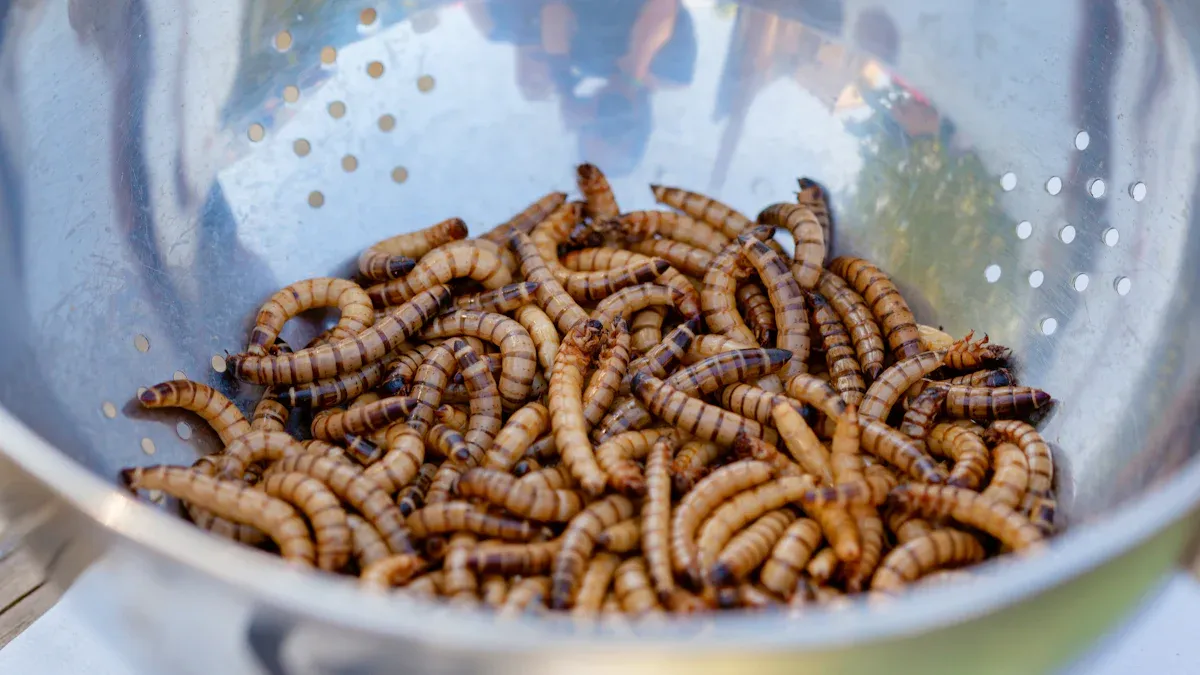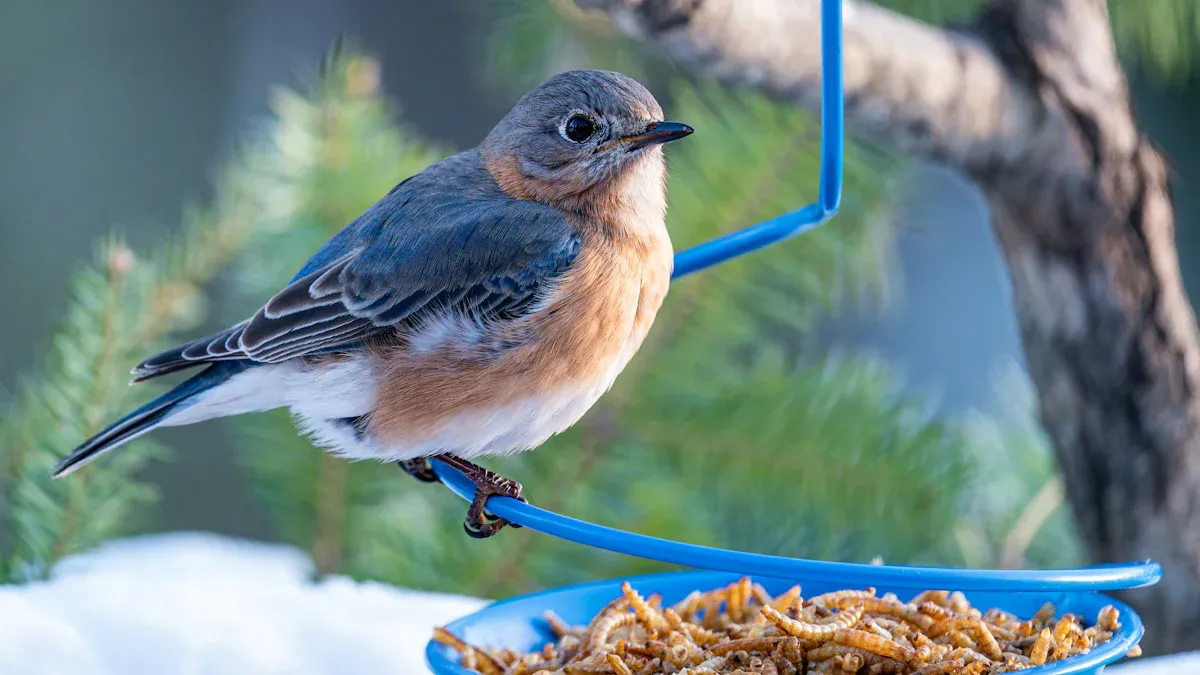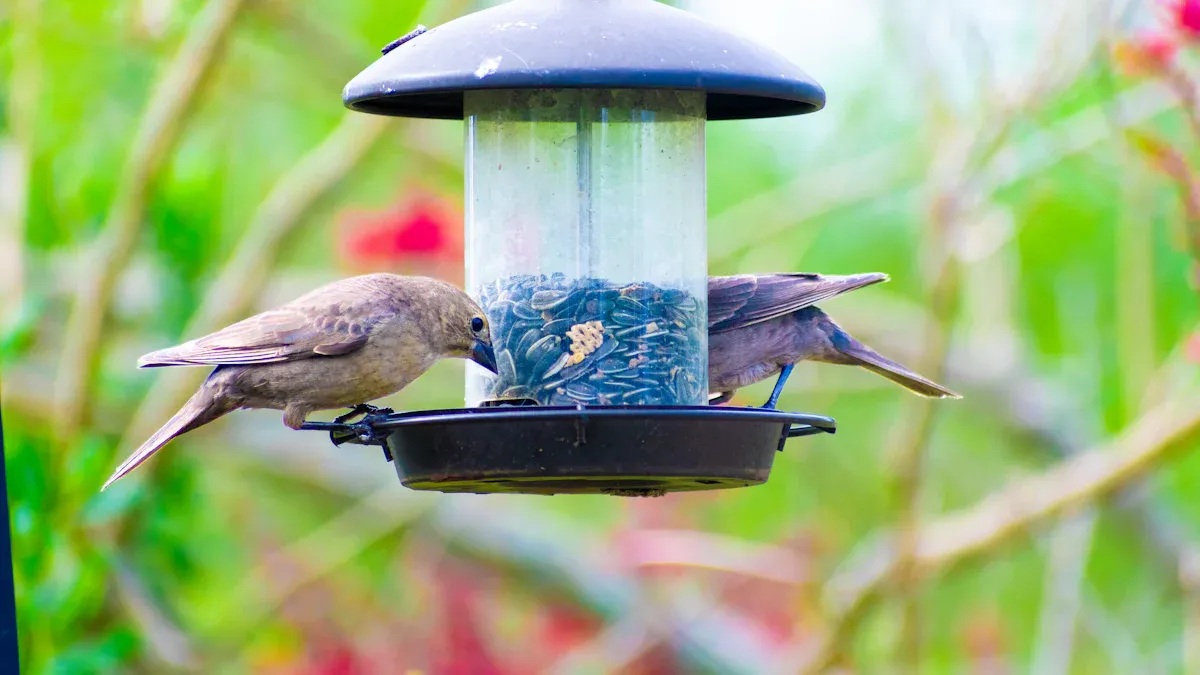
Imagine stepping outside to the cheerful songs of birds fluttering around your backyard. Feeding birds dried mealworms is a simple way to bring this joy to life. Packed with protein, these treats help birds stay healthy while turning your outdoor space into a lively, colorful haven filled with nature’s beauty.
Key Takeaways
- Dried mealworms are healthy snacks for birds. They give birds protein and vitamins, helping them stay strong during nesting and migration.
- Dried mealworms are easy to use. They last a long time and don’t need special storage, which is great for busy bird watchers.
- You can attract many bird types by adding dried mealworms to other foods. Put feeders in safe and easy-to-reach spots.
Benefits of Feeding Birds Dried Mealworms

Nutritional Value for Bird Health
Dried mealworms pack a powerful punch when it comes to nutrition. Birds need protein to maintain their energy levels, especially during nesting and migration seasons. Mealworms provide about 20% protein per 100 grams, making them an excellent source of this essential nutrient. They also contain healthy fats, which help birds stay warm during colder months.
But that’s not all. These tiny treats are loaded with important vitamins and minerals. Birds benefit from vitamins like B5, B12, and B2, which support their metabolism and overall health. Minerals such as calcium, magnesium, and zinc play a role in strengthening bones and feathers. Here’s a quick look at the nutritional profile of dried mealworms:
| Nutrient | Amount per 100g |
|---|---|
| Protein | 20% |
| Fat | 15% |
| Calories | 214 Kcal |
| Calcium | Notable amount |
| Iron | Notable amount |
| Zinc | Notable amount |
| Magnesium | Notable amount |
By feeding birds dried mealworms, you’re giving them the fuel they need to thrive. It’s a small gesture that makes a big difference in their health.
Convenience and Long Shelf Life
One of the best things about dried mealworms is how easy they are to use. Unlike live mealworms, these don’t require refrigeration or special care. They come ready to serve, making them perfect for busy bird enthusiasts.
Dried mealworms also have an impressive shelf life. You can store them for months without worrying about spoilage. This means you’ll always have a reliable food source on hand for your feathered visitors. Whether it’s a sunny summer day or a chilly winter morning, dried mealworms are a convenient way to keep your backyard birds happy.
Welcomed by a Variety of Bird Species
Dried mealworms are a universal favorite among many bird species. Bluebirds, chickadees, cardinals, and woodpeckers are just a few of the colorful visitors you might attract. Even robins, who are known to be picky eaters, appreciate this protein-rich snack.
These treats are especially helpful during challenging seasons when natural food sources are scarce. By offering dried mealworms, you’re creating a dependable food supply that supports birds through tough times. Plus, watching a variety of species flock to your backyard adds a splash of life and color to your outdoor space.
Tip: To maximize the variety of birds visiting your yard, try pairing dried mealworms with other bird foods like seeds or suet. This combination appeals to an even broader range of species.
Practical Tips for Feeding Birds Dried Mealworms
Choosing the Right Feeder
Selecting the right feeder can make a big difference in attracting birds to your backyard. A platform feeder or a rimmed dish works best for holding dried mealworms. These designs keep the mealworms contained, preventing them from scattering on the ground. Birds can easily spot and access the food, making it more likely for them to visit.
Placement is just as important as the feeder itself. Position feeders near shrubs or trees to create a sense of safety for the birds. Vegetation provides cover, helping them feel secure while they eat. To protect birds from potential harm, keep feeders away from windows to reduce the risk of collisions.
Tip: Clean your feeder regularly to prevent the buildup of bacteria or mold. A clean feeder ensures a healthy dining experience for your feathered friends.
Best Times to Offer Mealworms
Timing matters when feeding birds dried mealworms. Birds are most active during the early morning hours, making this the ideal time to offer food. Between 5:30 and 11:30 in the morning, birds are busy searching for energy-rich meals to fuel their day. Providing mealworms during this period ensures they get the nutrition they need when they need it most.
Morning feeding also prevents mealworms from overheating, especially during warmer months. This keeps the food fresh and appealing to birds. While mornings are best, you can also offer mealworms in the late afternoon to attract birds preparing for the evening.
Note: Consistency is key. Birds are more likely to return if they know they can rely on your backyard as a regular food source.
Using Mealworms as a Supplemental Food Source
Dried mealworms are a fantastic addition to a bird’s diet. They are high in protein and essential fatty acids, making them a nutritious treat. These mealworms are non-GMO and 100% natural, ensuring a safe and healthy option for your feathered visitors.
While dried mealworms are packed with benefits, they work best as a supplemental food source. Birds thrive on a varied diet that includes seeds, fruits, and insects. Adding mealworms to the mix provides an extra boost of protein, especially during nesting and migration seasons. Some bluebirds have even been observed feeding dried mealworms to their young, showing how valuable they can be.
Tip: Aim to make dried mealworms about 5-10% of the birds’ overall diet. This balance ensures they get the nutrients they need without relying solely on one food source.
Preparing Dried Mealworms for Birds
Soaking Mealworms for Hydration
Dried mealworms are a fantastic treat for birds, but soaking them in water can make them even better. Birds often need hydration, especially during hot summer days or dry seasons. Soaking mealworms softens them and adds moisture, making them easier for birds to eat and digest.
To prepare soaked mealworms, simply place them in a bowl of water for about 20 minutes. Once they’ve absorbed enough water, drain the excess liquid and serve them in a feeder. Birds like robins and bluebirds especially enjoy this hydrated snack. Soaking mealworms is a quick and easy way to enhance their nutritional value while keeping your feathered visitors hydrated.
Mixing Mealworms with Other Bird Foods
Combining dried mealworms with other bird foods creates a balanced diet that attracts a wider variety of species. Mixing them with seeds, suet, or fruit chunks adds variety and ensures birds get the nutrients they need. This approach works well for feeding birds dried mealworms as a supplemental food source.
For a simple mix, combine mealworms with sunflower seeds or crushed peanuts in a feeder. This blend appeals to birds like chickadees, cardinals, and woodpeckers. Adding suet during colder months provides extra energy, helping birds stay warm. A diverse mix keeps birds coming back for more while supporting their overall health.
Proper Storage to Maintain Freshness
Keeping dried mealworms fresh is essential for maintaining their quality. Storing them in the refrigerator is the best way to preserve their freshness. Refrigeration slows down their metabolism, extending their shelf life. Use a ventilated container, like a cardboard box or one lined with wheat bran or oats, to prevent moisture buildup. Airtight containers can lead to mold, so avoid them.
Mealworms can stay fresh in the fridge for several weeks, but it’s best to use them within a month. Proper storage ensures your birds always get high-quality food, making your backyard a reliable feeding spot.
Enhancing Your Backyard with Dried Mealworms

Attracting Colorful and Diverse Bird Species
Dried mealworms are like a magnet for colorful birds. Bluebirds, chickadees, cardinals, and woodpeckers are just a few of the species that love these protein-packed snacks. Even robins, who can be picky eaters, enjoy them. Offering dried mealworms creates a welcoming environment for birds, turning your backyard into a lively hub of activity.
To attract a variety of birds, place feeders in different spots. Some birds prefer open spaces, while others feel safer near shrubs or trees. Pairing mealworms with seeds or suet can also increase the diversity of visitors. Watching these vibrant creatures flutter around adds a splash of color and joy to your outdoor space.
Tip: Keep a bird guide handy to identify the species visiting your yard. It’s a fun way to learn more about your feathered friends!
Supporting Birds During Challenging Seasons
Birds face tough times during winter and migration seasons. Natural food sources become scarce, and they need extra energy to survive. Dried mealworms provide a reliable source of protein and fat, helping birds stay strong when they need it most.
In colder months, birds burn more calories to stay warm. Adding mealworms to their diet gives them the fuel they need. During migration, these snacks offer a quick energy boost for long journeys. By feeding birds dried mealworms, you’re lending a helping hand during their most challenging times.
Creating a Vibrant and Eco-Friendly Outdoor Space
A backyard filled with birds isn’t just beautiful—it’s also eco-friendly. Birds play a vital role in controlling pests and pollinating plants. By attracting them with dried mealworms, you’re supporting the natural ecosystem.
Planting native flowers and shrubs alongside feeders creates a bird-friendly habitat. These plants provide shelter and additional food sources, making your yard even more inviting. The combination of greenery and bird activity transforms your outdoor space into a lively, eco-conscious haven.
Note: Avoid using chemical pesticides in your garden. Birds help keep pests in check naturally, so let them do the work for you!
Feeding birds dried mealworms offers so many benefits. These protein-packed snacks help birds stay healthy, attract colorful species, and create a lively backyard environment. It’s a simple way to support nature while enjoying its beauty.
Tip: Start small! Add dried mealworms to your feeder today and watch your backyard transform into a bird haven.
FAQ
How often should dried mealworms be offered to birds?
Offer dried mealworms a few times a week. Birds benefit most when mealworms are part of a varied diet that includes seeds and fruits.
Can dried mealworms attract specific bird species?
Yes! Feeding birds dried mealworms can attract bluebirds, robins, cardinals, and woodpeckers. These protein-packed snacks appeal to many colorful and lively species.
Are dried mealworms safe for baby birds?
Absolutely. Parent birds, like bluebirds, often feed dried mealworms to their chicks. These treats provide essential nutrients for growing birds during nesting seasons.


